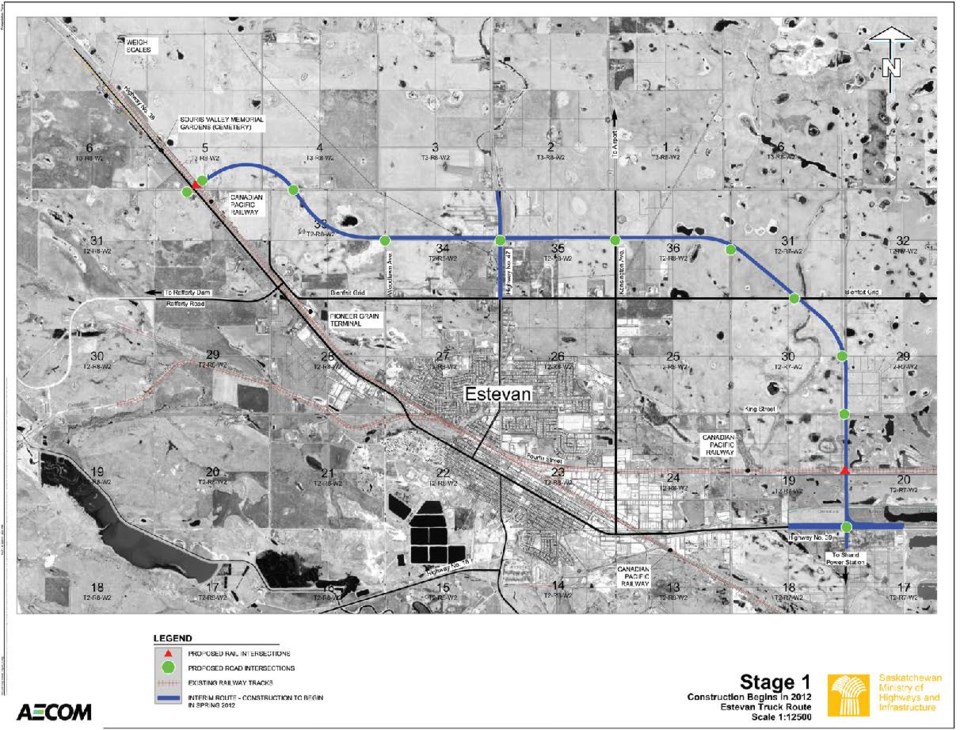Although construction is not expected to begin for over a year, the Ministry of Highways and Infrastructure has decided upon a location for the $44 million heavy truck bypass around Estevan.
The ministry held an open house last Wednesday at the Souris Valley Aquatic and Leisure Centre to give the public a look at the finalized route and an idea of when construction might finally begin.
As expected, the 12 kilometre bypass will be a two-lane road with enough space to allow for twinning in the future. Entry on the east side of the route will be gained at the intersection of Highway 39 and the Shand Access Road.
The west side intersection, which has been a source of controversy since the project was initially announced, has been moved over one kilometre west from its initial location near the turn to Rafferty Dam and the Pioneer Grain Terminal.
Brent Miller of the Ministry of Highways said he is happy with the plan they presented, calling it a very good move forward.
"We spent a lot of time and a lot of effort discussing with all our stakeholders, getting their feedback and getting public feedback," said Miller. "We have spent a lot of time and effort making sure what we are planning and designing is going to work for everyone. I am quite confident in it."
Miller said the designs that were presented at the open house are still just conceptual and that the actual design work will take place over the next year or so. He added the design for the east intersection went relatively smooth.
"We'll be getting into it in more detail in the detailed design (stage) and looking at how we are going to tie in the traffic of the old Highway 39 and the new truck route and looking at the turning movements and how to work through all of that. There is still a lot of engineering work that needs to be done."
While plotting the east intersection went smoothly, the same could not be said for the west intersection. The initial location drew a great deal of criticism due to numerous safety concerns and it's proximity to the Pioneer Grain Terminal.
Those comments prompted the ministry to move the intersection further west to avoid any issues with the grain terminal. However, there were still concerns that the new option still presented a significant safety hazard, prompting calls for the province to include an interchange in the design.
Miller said although many have called for an interchange to avert any potential safety issues, the feedback from the public indicated they are in favour of moving the intersection west of the Pioneer Terminal.
"There weren't really any negatives on the option we are selecting," he said. "Obviously there is an interest in getting that interchange. There were no negative comments regarding Option 1, it's just that they had a preference to do the interchange right away."
Miller noted there were two factors the ministry considered with regards to the interchange - cost and necessity.
In terms of cost, there are reports an interchange could cost well over $20 million although there has been some debate about that figure. As for need, Miller said that based on their projections, an interchange is not warranted at this time.
"We will continue to evaluate and once the truck bypass is in place, we'll have an opportunity to see actual numbers. If things change or economic development really spikes up and we see a change in truck movements, composition and volumes, you never know, it could trigger something sooner rather than later."
As for the future, Miller said with the open house behind them, the next stage is to work on such tasks as detailed design, land procurement, environmental concerns and utility location.
"Ideally, if everything goes the way we would like, we hope to procure a contractor next fall and start beginning some of the early stages of construction by fall 2012," said Miller."




